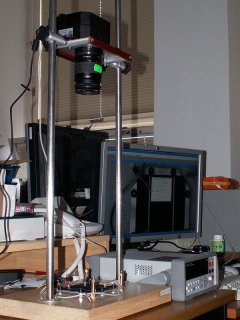|
The G2-3200 CCD camera is used with off-the-shelf Canon EOS
photographic lens to capture luminescence of electronics devices.

G2-3200 camera and Canon EOS lens before placing into dark
room The following example shows experiments performed by the research
team at the Brno University of Technology. The experiment shows
micro-plasmas, created in a fraction of mono-crystal solar cell.
Micro-plasmas are created in the places where the silicon is
contaminated.
Mono-crystal solar cell fragment (left) and its visible
light image in the test bed (right) When the voltage is applied to the solar cell fraction in the
conductive direction, is starts to emit light in the near infra-red
portion of spectrum. CCD camera with low-pass filter passing light
with wave lengths longer than 740 nm show
the electro luminescence. Applying voltage in the barrier direction
shows micro-plasmas created in the places of silicon
contamination.
Near IR luminescence of solar cell with applied voltage in
conductive direction (left) and micro-plasmas after applying voltage
in barrier direction (right) Another example shows the so-called whirlpool defect of
mono-crystal solar cells. This defect is visible if voltage is applied
in conductive direction, voltage in barrier direction shows
micro-plasmas like in previous example.
Whirlpool defect of solar cell (left) and micro-plasmas on
the same cell (right) | 